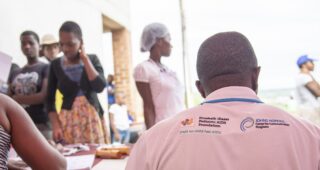Saving Lives at Birth in Central and Southwest Uganda
You are here
Of the 120,000 HIV-exposed infants (HEI) born every year in Uganda, over 50,000 lack proper access to Nevirapine (NVP) during their first few months of life. NVP is not only hard to distribute to women in rural communities, but its high-viscosity and stickiness make it difficult to measure and ultimately ensure accurate dosage.

To address this inequality, EGPAF Uganda Country Director Dr. Edward Bitarakwate partnered with Pratt Pouch Consulting and the Uganda Ministry of Health to create the National Scale-up of the Pratt Pouch to Expand Infant Nevirapine Prophylaxis in Uganda. After receiving the People’s Choice Award for this project at USAID’s annual Saving Lives at Birth Development XChange Innovation Pitch Completion in 2015, Dr. Bitarakwate returned to the 2018 competition in Washington, DC to give a 15-minute pitch on his team’s progress and future goals.
The original Pratt Pouch, developed in 2008 by Duke’s Pratt School of Engineering, made big waves in preventing Mother-to-Child transmission of HIV in countries such as Ecuador, Zambia, and Tanzania. By squeezing the ketchup-sized packet into the mouths of their newborns, HIV-mothers provide heightened dosing accuracy, ultimately preventing new infection. The success stemmed greatly from the pouch’s convenience, accessibility, and the precise NVP dosages contained in each.
Since their project began in 2016, Dr. Bitarakwate and his team aimed to create a fully operational packaging facility where each Pouch would travel through an assembly of NVP insertion, secure sealing, and labeling with exact dates. The packages produced at this facility would be distributed among 500 health facilities in 22 districts of Southwest and Central Uganda. In Dr. Bitirakwate’s pitch, he confirmed that to this point all equipment has been installed at the repackaging facility, packaging designs and training curriculums have been approved by the appropriate agencies, and conducted a formative study.
“This is really a key milestone for us,” Bitarakwate noted, “We were able to take something designed by engineers, innovate it, quality test it, and introduce into a supply chain that will ultimately help reduce the transmission of HIV from mother to infant”
Another significant feature of this program is the use of direct family engagement to monitor medication adherence and track program success. By follow-up directly with each mother and treating each individual case directly, Dr. Bitarakwate and his team have experienced drastic positive behavior change. “At the end of the day, the individual patient needs to know what exactly they are taking and what they need to do,” Bitarakwate added.

While the program team has received approval for their effectiveness study from the local IRB they are still awaiting implementation in Uganda to begin dispersing the 6-week prophylaxis regimen. The current plan hopes to have ten thousand HIV-positive pregnant and lactating mothers and their HIV-Exposed Infants (HEI) enrolled by year two, ultimately increasing that number to 30,000 by year three.
This innovative model for the Pratt Pouch aims to help Uganda meet the 90-90-90 goals for HIV/AIDS infections in Uganda and work towards ending mother-to-child transmission of HIV. Dr. Bitarakwate comments, “This innovation is striving for 0 new infections by making sure infants get the full compliments of treatment early enough that it will actually prevent HIV infection. That is the first 90. The second and third 90 are achieved through direct follow-up and engagement with the families to ensure they are all receiving the full range of treatment and are complying with the treatment.”
Uganda
Pediatric HIV Diagnosis, Care & Treatment



